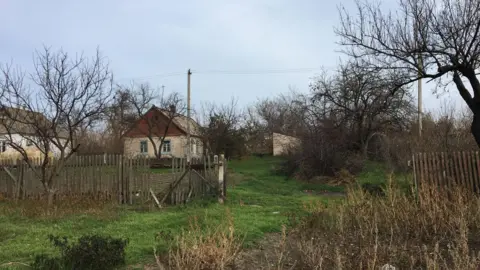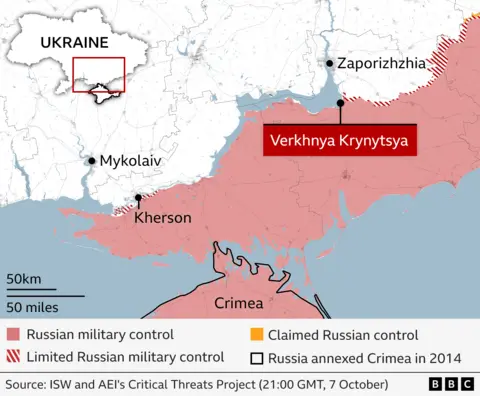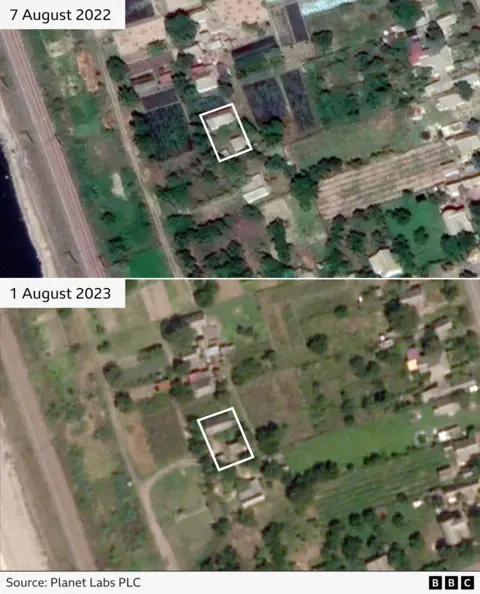Have Russians set up a military base in my childhood home?

It was another busy day at work.
Russian forces had attacked my home region of Zaporizhzhia again: a region in the south of Ukraine, split between the Russian invaders, who claim it all as theirs, and the defending Ukrainians.
Sitting in my office in central London, I was feeling nostalgic. I decided to take a quick look at the latest satellite images of my childhood village - the poetically titled Verkhnya Krynytsya (or Upper Spring in English), in the Russian-occupied part of the region, just a few kilometres from the front lines.
I could see the familiar dirt tracks, and the houses drowning in lush vegetation. But something caught my eye.
Amid all the apparent quiet of a small village that I remember so well, a new feature had appeared: a well-used road. And it led right to my childhood home.
Satellite images show a path first appearing in the summer of 2022, four months after the occupation began. Images from winter showed it reappearing and a car making use of it in January 2023.
I could think of only one group of people who could be using the path in an occupied village so close to the front line: Russian soldiers. Only they have reason to be out and about in a war zone.
The truth is that my childhood village is not quiet anymore. Verkhnya Krynytsya was occupied by Russia shortly after the start of the full-scale invasion in February 2022.
By that point, my old house was likely vacant. My family had sold it long ago, but I visited Verkhnya Krynytsya at least once a year before it was occupied, and saw the house sitting apparently abandoned, its garden overgrown.

It was hardly surprising: the village was small and sleepy at the best of times, and for anyone still under retirement age, looking for work meant moving elsewhere.
But many stayed, and more than a thousand people were still there when Russia launched its invasion. Two days later, Ukrainian authorities handed out 43 Kalashnikov rifles to help the villagers fight off the Russians.
At a community gathering, residents decided not to use them against the invaders. A month later, village head Serhiy Yavorsky was captured by the Russians, who beat and tortured him with electricity, needles and acid, according to testimony given in a Ukrainian court.
The Russians also targeted a sewage treatment works outside the village and set up a command post there once the Ukrainians had abandoned the facility.

Even the village's surroundings have changed irreparably.
Before Russia's full-scale invasion, Verkhnya Krynytsya sat on the beautiful Kakhovka reservoir, which was so vast we used to call it "the Sea".
You could see it from pretty much anywhere in the village. It's where locals went swimming in the summer, and where visitors from across the region came in the winter to go ice-fishing. One of my earliest memories is of local women singing Ukrainian folk songs as the sun was setting into the Kakhovka on a warm summer evening.
The Sea disappeared after the Kakhovka dam was destroyed in June 2023, leading to devastating floods that ruined homes and farmland.
To find out what conditions in Verkhnya Krynytsya are like now, I tried reaching out to locals.
Predictably, obtaining answers was very difficult.
Many have left, and those who are still in the village - as is the case in the other occupied parts of Ukraine - are afraid of speaking to the media. Frontline locations are particularly lawless places, where retribution from Russian forces can be swift and brutal.
Social media groups about Verkhnya Krynytsya went silent after it was occupied, and the questions I posted there were left unanswered.
Asking someone to go and have a look at my house was out of the question. What used to be a peaceful, sleepy village has turned into a zone of fear.
The danger in Verkhnya Krynytsya also comes from the sky. The village's proximity to the front line means it is a dangerous location, exposed to frequent aerial attacks from the Ukrainians.
One acquaintance told me that locals preferred to stay indoors for fear of being hit by drones. "It's very dangerous there," I was told. "They are active, and they can target you, your house or your car. Our village has changed a lot, Vitaly."
So, given the danger and devastation caused to Verkhnya Krynytsya by the war, who could have possibly made the track marks leading to and from my old home?
It is highly unlikely anyone would choose to move to the village now - with the exception of Russian soldiers.
Many of them moved into vacant houses after capturing Verkhnya Krynytsya. In June 2022 authorities in Zaporizhzhia said they had information that Russian troops were staying in the village. This is when satellite images first show signs of the path at my old home.
To check if I was right in assuming that Russian soldiers had likely moved into my old house, I approached the Ukrainian 128th Detached Heavy Mechanised Brigade, which is involved in operations in the area.
"You're not wrong. It's extremely likely," its spokesman Oleksandr Kurbatov told me.
As locals have been fleeing frontline areas, they are being replaced with Russian military, he said.
"If there are not enough empty houses, demand is running high. Of course, it's usually military personnel from the occupation army," he told me.
Because nobody in the village was willing to take the risk of having a look at my house, I asked my BBC Verify colleague Richard Irvine-Brown to obtain and analyse recent satellite images. They showed a pattern of movement around the house where I grew up.
There was no sign of a path to the property in March 2022, a month into the invasion.
Aside from the faint path seen in two satellite images in June, the property seemed ignored. Then the path reappeared in December, and a car was seen using it in January 2023. We don't have any images for the property again until August, by when the track had become well established.

The path fades and reappears with the seasons, showing that whoever is using it only does so periodically.
It seems the property is being used during the winter - and likely by Russian soldiers, who have been moving into vacant properties. This is plausible, as biting Ukrainian winters can make it too cold for men or their supplies to stay in trenches, makeshift dwellings and storage.
The truth about what happened to my house may not become known for a long time yet - certainly not while the village is under occupation.
For now, it seems that my old home has become a tiny cog in the wider machine of Russia's war in Ukraine.
BBC





